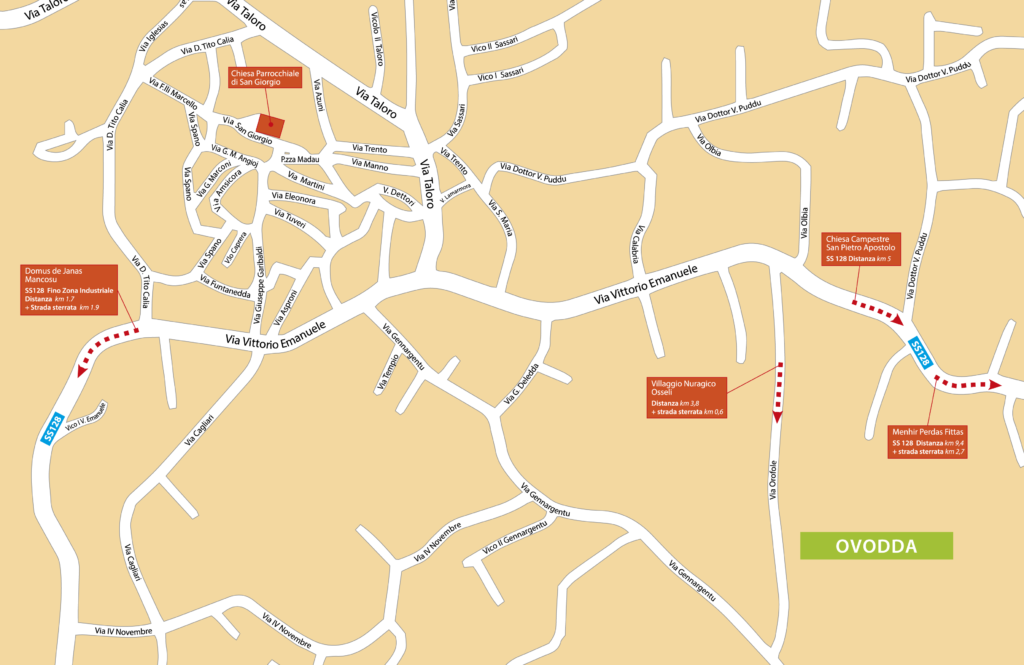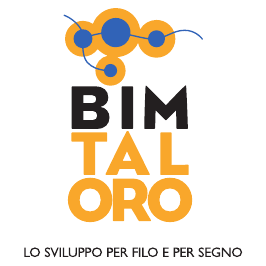Church of San Giorgio Martire
The first evidence of the existence of the parish church of San Giorgio dates back to 3 October 1666, according to the Quinque libri, and stands in what is now the centre of the village. The building replaced the previous parish church dedicated to Saint Mary, mentioned as early as 1627 in the Quinque libri ovoddesi, while its last record as a parish church was in 1652. The temple and its churchyard were used as a burial site until 1926. In the 1950s, the remains of the ancient temple, which stood at the highest part of the village, were demolished to make way for a car park square.
On the façade of the parish church of San Giorgio, marked by four vertical pilasters, there is a large circular window and a central doorway supported by jambs and architraves made of grey granite, the same stone that horizontally borders the façade at the top with a rhythmically repeated palmette motif. Above it is the gable on top of which is a small stone cross. On the right side of the building stands the square bell tower, also made of granite, which was extended and raised to its present form in the latter part of the 18th century.
The church’s main door and entry cubicle have wooden shutters decorated with flat ovoid rosettes, all made, as the date engraved on an interior architrave indicates, in 1876.
The parish church, in late Gothic style, has a single nave covered by a pointed arch vault built in the 1870s, with three chapels and two side chapels on each side, all covered by barrel vaults; in one of these is the marble baptistery, probably dating back to the 19th century, on the front of which the Baptism of Jesus at the hands of the Baptist is depicted in vivid colours.
The presbytery, which is slightly raised above the floor of the room, houses the marble high altar. Here, the frontal reproduction of St. George spearing the Dragon was made in 1900, as was the marble balustrade that encloses the entire area. The building has undergone several renovations and alterations over the centuries, one of which is documented to have taken place in 1871; the only part remaining of the original structure is the main chapel with a cross-vaulted ceiling and a pendulous gemstone depicting St. George and the Dragon at the point where the ribs intersect. The vault of the choir is decorated with several stuccoes depicting angels, probably from the 18th century, which, in terms of style and craftsmanship, appear to be by the same hand as those found in the Basilica dei Martiri in Fonni.
Of particular interest are the eight statues preserved in the temple, dating from the 17th to the early 19th century, which represent: Saint Peter Enthroned, Saint Peter the apostle, Saint Isidore the Farmer, Saint Anthony the Abbot, Saint Anthony of Padua, a processional Crucifix and an altar Cross, and finally a Dormitio Virginis (Sleeping Virgin).
The wooden sculpture of Saint Peter Enthroned of the Neapolitan school, carved by Alfonso del Vecchio (who established his workshop in Gavoi between 1642 and 1646) and dated 1643, can be admired in the church chapels. The statue today appears in its original gilding, thanks to a restoration project carried out in 2012.
The statue of the Virgin of the Assumption, usually placed inside a shrine in a side chapel in the days immediately preceding the feast day (15 August), is displayed on a wooden bed decorated in bright colours: only the ends are carved, while the rest of the body is made of a linen or hemp cloth filled with straw. These types of simulacra date back to the late 18th or 19th century.
Also dating back to the 17th century are the two Crucifixes, one placed above the High Altar, which, considering its archaic pose, may be even older, and the other, a processional Crucifix from the Confraternity of the Holy Cross, which is said to have been used from 1711 until 1919, when the confraternity was disbanded.
One of the two side chapels displays a statue of Saint George the martyr, depicted in the act of slaying the dragon lying at his feet, dating from the late 19th century.
Inside the sacristy are the statues of Sant’Isidore driving oxen and Saint Anthony the Abbot, dating from the 17th to the early 18th century. Both are in excellent condition, thanks to the restoration work carried out in 2012. Also inside the sacristy is the small statue of Saint Peter the Apostle, which may have been made in the 17th century by a Sardinian workshop, and which was also recently restored. Of particular interest is the sacristy cabinet (Paratora), made in marquetry, dating back to 1765.
The feast of the saint, patron of the town, is celebrated on 23 April.
Text by Laura Melis with the contribution of Sandra Cinelli

 BIM TALORO
BIM TALORO